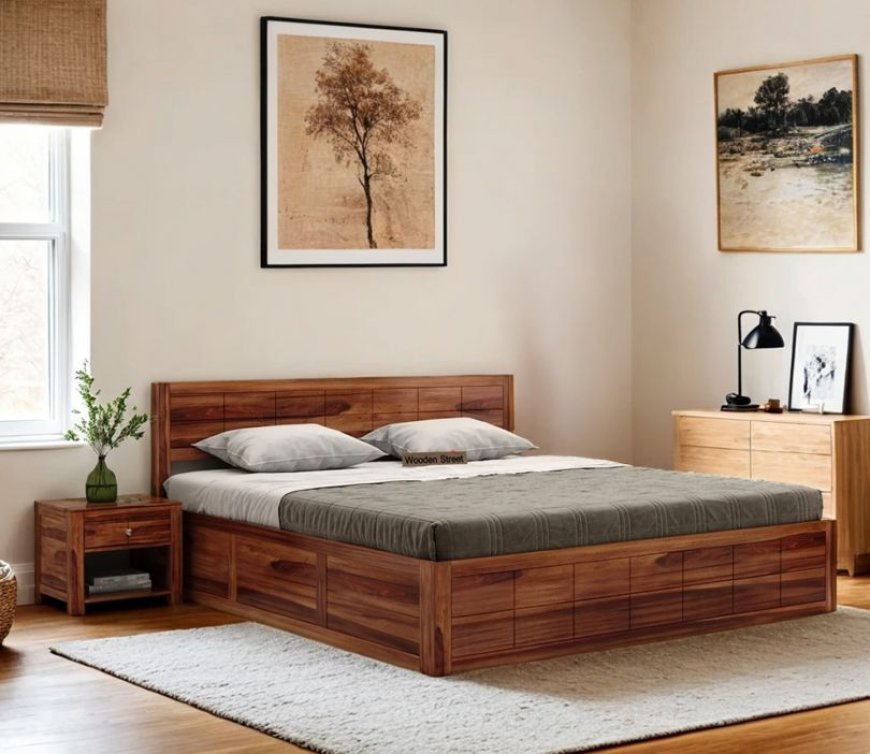What Materials Are Best for Bed Design | Wooden Street

Choosing the right material for a bed design is crucial for creating a bedroom that balances aesthetics, durability, and comfort. The material you select impacts not only the look and feel of the bed but also its longevity and maintenance needs. From classic wooden bed designs to modern metal or upholstered options, each material offers unique benefits. This article explores the best materials for bed design, including insights into Wooden Street’s offerings, to help you make an informed decision.
Why Material Matters in Bed Design
The material of a bed frame defines its style, functionality, and how well it integrates into your bedroom’s decor. A well-chosen bed design can elevate the ambiance, whether you’re aiming for a rustic, minimalist, or luxurious aesthetic. Factors like durability, maintenance, cost, and environmental impact also play a role in material selection. Let’s dive into the most popular materials for bed designs and their pros and cons.
1. Wood: The Timeless Choice
Wood remains a top choice for wooden bed designs due to its versatility, durability, and natural beauty. It suits a wide range of aesthetics, from traditional to contemporary.
Benefits of Wooden Bed Designs
-
Durability: High-quality woods like teak, sheesham, and oak are sturdy and long-lasting, making them ideal for daily use.
-
Aesthetic Appeal: Wood’s natural grain adds warmth and character. Wooden Street, for example, offers wooden bed designs with intricate carvings or sleek, modern finishes to suit diverse tastes.
-
Customizability: Wood can be stained, painted, or polished to match your bedroom’s color scheme.
-
Eco-Friendly Options: Sustainably sourced wood is an environmentally conscious choice.
Drawbacks
-
Cost: Premium woods like teak or walnut can be expensive.
-
Maintenance: Requires periodic polishing or treatment to prevent scratches or termite damage.
-
Weight: Solid wood beds are heavy, making them harder to move.
Wooden Street’s Contribution: Wooden Street excels in crafting wooden bed designs using high-quality materials like sheesham and mango wood. Their beds range from minimalist platform styles to ornate four-poster designs, offering durability and elegance for every budget.
2. Metal: Sleek and Modern
Metal bed frames are a favorite for those seeking a contemporary or industrial bed design. Materials like wrought iron, steel, or aluminum are commonly used.
Benefits of Metal Bed Designs
-
Strength: Metal frames are incredibly sturdy and resistant to wear and tear.
-
Low Maintenance: Unlike wood, metal doesn’t require polishing and is less prone to pest damage.
-
Versatility: Available in minimalist or ornate designs, metal beds fit modern and vintage aesthetics alike.
-
Affordability: Metal beds are often more budget-friendly than solid wood.
Drawbacks
-
Noise: Metal frames can sometimes creak, especially if not assembled properly.
-
Cold Feel: Metal lacks the warmth of wood, which may not suit cozy bedroom vibes.
-
Rust Risk: Lower-quality metal may rust if exposed to moisture.
Best Use: Metal beds are ideal for urban or industrial-style bedrooms. Pair them with soft bedding to balance their sleek look.
3. Upholstered Beds: Comfort Meets Style
Upholstered beds, featuring fabric or leather coverings, are synonymous with luxury and comfort. They’re perfect for adding a plush, inviting feel to a bed design.
Benefits of Upholstered Bed Designs
-
Comfort: Padded headboards and frames offer a cozy, cushioned feel, ideal for reading or lounging in bed.
-
Aesthetic Variety: Available in fabrics like velvet, linen, or leather, upholstered beds suit modern and classic styles.
-
Sound Insulation: Fabric reduces noise compared to metal or wood frames.
Drawbacks
-
Maintenance: Fabrics can stain or wear out, requiring regular cleaning.
-
Cost: High-end upholstery materials like leather can be pricey.
-
Durability: Less durable than wood or metal, especially with heavy use.
Wooden Street’s Offerings: Wooden Street incorporates upholstered elements in some of their wooden bed designs, blending fabric headboards with sturdy wooden frames for a hybrid look that’s both stylish and durable.
4. Engineered Wood: Budget-Friendly and Modern
Engineered wood, such as MDF or plywood, is a cost-effective alternative to solid wood, often used in modern bed designs.
Benefits of Engineered Wood
-
Affordability: Significantly cheaper than solid wood, making it accessible for budget-conscious buyers.
-
Lightweight: Easier to move and assemble compared to solid wood.
-
Versatile Finishes: Can be laminated or veneered to mimic the look of premium wood.
Drawbacks
-
Durability: Less sturdy than solid wood, with a shorter lifespan.
-
Moisture Sensitivity: Can warp or swell if exposed to humidity.
-
Environmental Concerns: Some engineered woods use adhesives that may not be eco-friendly.
Best Use: Engineered wood is great for temporary or budget-friendly bed designs, especially in guest rooms or kids’ bedrooms.
5. Bamboo: Sustainable and Stylish
Bamboo is gaining popularity for eco-conscious bed designs due to its sustainability and unique aesthetic.
Benefits of Bamboo Bed Designs
-
Eco-Friendly: Bamboo grows quickly, making it a renewable resource.
-
Lightweight yet Strong: Offers durability without the heft of solid wood.
-
Unique Aesthetic: Its natural texture adds a tropical or minimalist vibe.
Drawbacks
-
Limited Styles: Bamboo beds may not suit all decor styles, leaning heavily toward bohemian or tropical themes.
-
Availability: Less common than wood or metal, which may limit options.
Choosing the Right Material for Your Bed Design
When selecting a material for your bed design, consider the following:
-
Budget: Solid wood or upholstered beds are pricier, while engineered wood and metal are more affordable.
-
Aesthetic: Match the material to your bedroom’s style—wood for warmth, metal for sleekness, or upholstery for luxury.
-
Durability: If you need a long-lasting bed, opt for solid wood or metal.
-
Maintenance: Choose low-maintenance materials like metal if you prefer minimal upkeep.
-
Sustainability: Bamboo or sustainably sourced wood is ideal for eco-conscious buyers.
Wooden Street offers a wide range of wooden bed designs that cater to various preferences, from budget-friendly engineered wood options to premium teak beds. Their designs blend functionality with style, making them a go-to for quality furniture.
Conclusion
The best material for your bed design depends on your style, budget, and practical needs. Wood offers timeless elegance, metal provides modern durability, upholstered beds add luxury, engineered wood is budget-friendly, and bamboo is eco-conscious. By exploring options like those from Wooden Street, you can find a wooden bed design or other material that perfectly suits your bedroom. Invest in a bed that not only enhances your space but also ensures comfort and durability for years to come.
What's Your Reaction?

































































